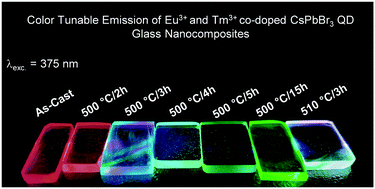Color tunable emission from Eu3+ and Tm3+ co-doped CsPbBr3 quantum dot glass nanocomposites†
Abstract
Cesium lead bromide (CsPbBr3) quantum dots (QDs) have shown great potential in the field of luminescent materials owing to their superior optical and electrical properties. However, instability and lack of multicolor emissions resulting from the intrinsic nature of CsPbBr3 QDs are still the major challenge for their commercialization. Herein, Eu3+ and Tm3+ co-doped CsPbBr3 QD glass nanocomposites (GNCs) are successfully synthesized via traditional melt-quenching followed by a heat-treatment route to obtain tunable emission in a durable host material. Tm3+ ions are doped to blue-shift the main emission peak of CsPbBr3 QDs, while Eu3+ ions are incorporated to compensate for the red deficiency. Accordingly, a tunable color emission spanning the entire visible spectrum is achieved from GNCs with a fixed composition. The incorporation of Eu3+ and Tm3+ ions promotes the crystallization of CsPbBr3 QDs in the glass host resulting in ∼100% photoluminescence quantum yield (PLQY) using a dilution method. The selected glass host has also been proven to effectively protect CsPbBr3 QDs against chemical, thermal and photo degradation. Interestingly, the selected Eu3+/Tm3+ co-doped CsPbBr3 QD GNC shows warm-white light with a low color temperature of 3692 K without utilizing any commercial phosphors. This indicates that the produced GNCs have the potential to be used as light convertor materials in multi-color LED or warm white LED applications due to their robust stability and extremely pure and tunable emission colors.

- This article is part of the themed collection: Quantum Dots: Celebrating the 2023 Nobel Prize in Chemistry


 Please wait while we load your content...
Please wait while we load your content...